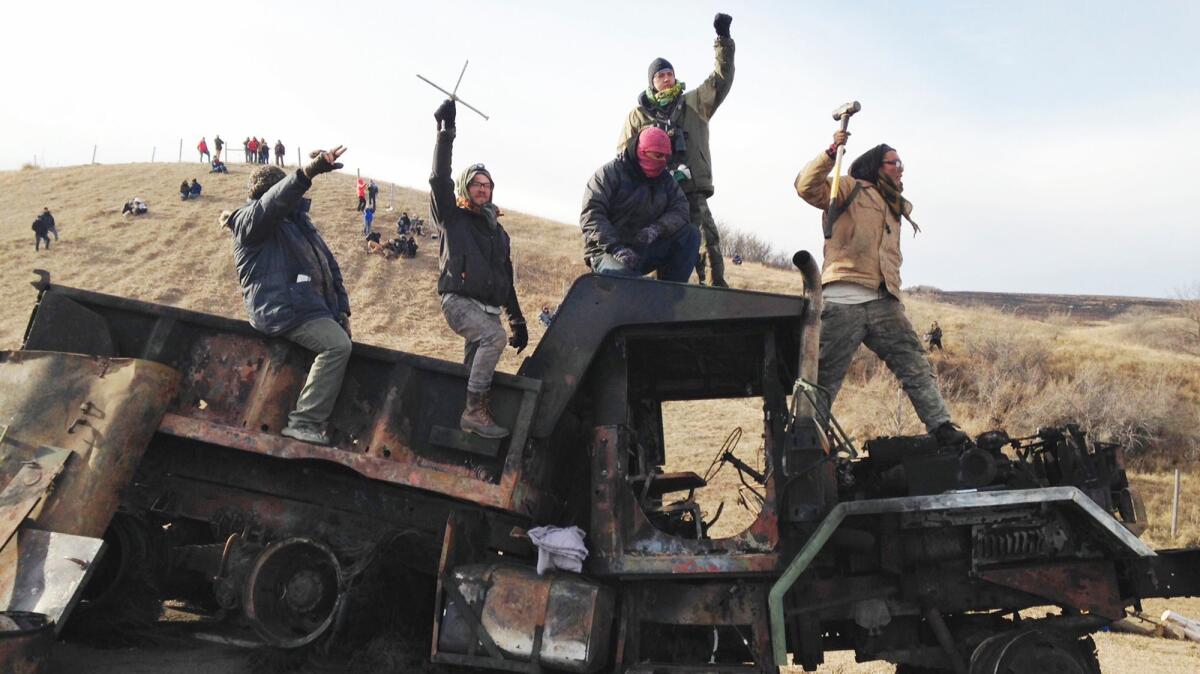Dakota Access pipeline protesters vow to continue, despite threat of more dousing with hoses

- Share via
Reporting from Along the Cannonball River, N.D. — Opponents of the Dakota Access oil pipeline vowed Wednesday to keep protesting despite a clash this week in which law enforcement officers fired rubber bullets and pepper spray at demonstrators and doused them with water hoses in subfreezing temperatures.
Interviews on a chilly Wednesday morning at the main protest camp evoked a chaotic, frightening scene as dozens of demonstrators were rushed into wood-fired camp kitchens for “aggressive rewarming” and “vigorous painful stimulation” after being soaked by the officers.
Noah Morris of the Standing Rock Medic and Healer Council said more than 300 people were treated for hypothermia and other ailments during the confrontations that erupted Sunday night and continued into Monday.
“We had folks at the falling-down stage, groups huddling and shivering, in whole-body convulsions,” Morris said. Some were “visibly covered in ice in heavy parkas. You could see the ice shining and cracking as they moved, falling off their shoulders and elbows.”
One protester, Sophia Wolansky, 21, from the Bronx, N.Y., remained hospitalized Wednesday in Minneapolis after suffering an arm injury during an explosion early Monday. Protesters said she was hurt by a concussion grenade thrown by law enforcement, while authorities suggested she was hurt by a propane cylinder that they speculated protesters were rigging up to hurl at the officers.
The clashes were the latest in a months-long standoff between law enforcement and protesters, during which more than 500 people have been arrested.
Developers say the 1,170-mile pipeline would provide a vital and safe means of transporting as much as 570,000 barrels of crude oil daily from North Dakota to an existing pipeline in Illinois.
But the project has stirred controversy because it would cross the Missouri River just half a mile north of the Standing Rock Sioux reservation, which the tribe believes could harm its drinking water and Native American cultural sites. Members of about 300 tribes from around the country have joined with environmental activists to fight the $3.8-billion project.
Last week, the U.S. Army Corps of Engineers declared that more study was needed before it could issue a permit to complete the pipeline, which is more than 80% built. The developer, Energy Transfer Partners, then sued in federal court to resume construction.
Sunday night’s clashes began when activists attempted to remove burned-out vehicles from a previous protest that are blocking access to Backwater Bridge. Police have said the vehicles are not safe to move until the bridge is examined for damage. But activists say they are hampering travel by local residents, including delaying ambulances that need to reach the city of Bismarck, to the north.
Local officials said hoses were brought in to put out fires on the bridge, but acknowledged using them against “criminal agitators.”
At a news conference Monday, Morton County Sheriff Kyle Kirchmeier said he was “confident that the decision made to use water was the correct one.” If a similar situation arises in the future, he added, he wouldn’t hesitate to use water again.
“It was effective, wasn’t it?” said a grim-faced Jason Ziegler, the police chief of Mandan, a small city outside Bismarck. “We can use whatever force necessary to maintain peace.”
At least one independent hypothermia expert questioned the decision, however.
“I would consider it a poor option,” said Steven Bergman, a physician who oversees medical care for 13 prisons in Michigan. “There’s no question they’re putting these people at risk. Just exposing them to the soaking effects of water at those temperatures is clearly putting their health in jeopardy.”
He added that in the prison system where he works, “that wouldn’t be considered.”
Authorities did not respond to repeated requests for comment about the threat of hypothermia under Sunday night’s conditions.
A number of hypothermia victims described a burning sensation as water from the hoses soaked their bodies and ice quickly began forming on their clothes and in their hair.
“All my clothes were literally frozen solid,” said Tony Zavlan of the Chumash Nation, who lives in Santa Barbara. “My hands weren’t working. They were like a deep purple color. In my hair, I basically had dreadlocks of ice.”
Both sides said that the dousing continued for hours, as water tanks were drained and hoses reconnected to full ones.
“They were just blasting people,” said Zavlan.
Despite the violence and increasingly cold temperatures, there is no indication that protesters will take down their teepees any time soon.
“Everybody says, no, we won’t leave now,” said Samuel Hannah, from the Havasupai reservation, at the bottom of the Grand Canyon. “Even when this weather comes, and the snow comes, everybody is willing to stay here.”
On Thursday, actresses Jane Fonda and Shailene Woodley plan to help serve a Thanksgiving meal for up to 2,000 Native Americans and their supporters at the Standing Rock reservation.
Tolan is a special correspondent.
ALSO
Trump reaches beyond loyalists and adds diversity with latest Cabinet picks
How a mosquito bite led to paralysis — and turned this teacher’s life upside down
The man who killed a Kansas abortion provider has his sentence reduced
More to Read
Sign up for Essential California
The most important California stories and recommendations in your inbox every morning.
You may occasionally receive promotional content from the Los Angeles Times.












